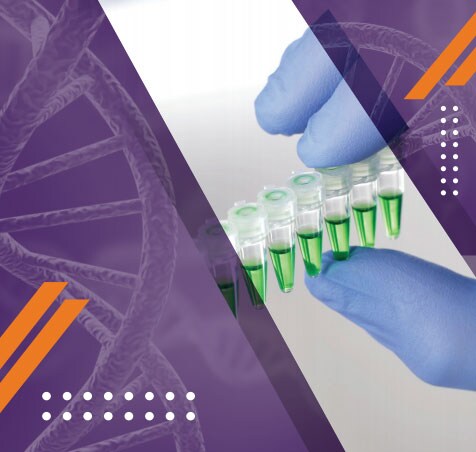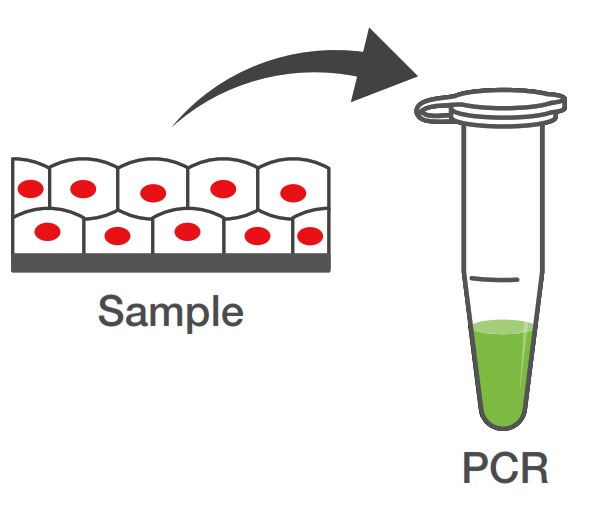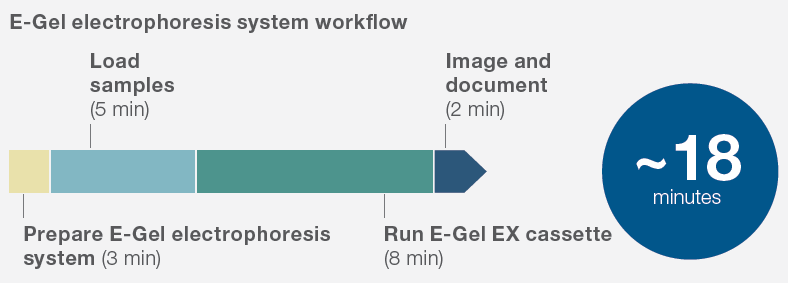Search
5 Steps to Efficient PCR

The polymerase chain reaction (PCR) is a sensitive and efficient method for amplifying a single copy of a target DNA sequence to millions of copies. Target DNA detection and/or amplification by PCR is an important step in cloning, gene expression analysis, genotyping, sequencing, and mutagenesis. PCR has a broad range of applications, including in research for infectious diseases, cancer, forensic analysis, and agricultural biotechnology.
For efficient endpoint PCR with fast and reliable results, here are five key steps to consider:
DNA isolation

DNA isolation is a crucial first step in the PCR workflow, whether you are isolating genomic DNA (gDNA) or bacterial plasmids. Selecting nucleic acid purification products that are optimized to provide maximum yield, purity, and integrity from virtually any sample type and application is important for your research success.
Common nucleic acid isolation methods include:
Organic extraction | Spin column | Magnetic beads | |
| Benefits |
|
|
|
| Product offerings | |||
To determine which purification kit is appropriate for your DNA type and sample type, use our interactive selection guide
Recommended DNA extraction products
Tired of purifying DNA for PCR?

Check out a universal direct PCR master mix that works with different sample types. No DNA purification needed!
Helpful links for DNA extraction
Primer design

Good design (i.e., good sequence selection) and high-quality primers are critical to your PCR reactions. In general, a length of 18–30 nucleotides for primers is optimal. The melting temperatures of the primers should be between 65°C and 75°C, and within 5°C of each other.
Forget the hassle of designing primers whether you are handling one or 50 genes. Take advantage of the benefits offered by our robust and easy-to-use Primer3-based OligoPerfect Designer
Custom oligos manufacturing
From the start of your oligos order to follow ups and special requests, we are here to meet your needs.
Ordering custom DNA oligos
The appropriate synthesis scale and purification for your application depend on the nature of your downstream applications. We offer oligos made to your specifications, with rigorous quality control, and quick turnaround for PCR and a variety of other applications. Learn more about Invitrogen custom DNA oligos
Oligos ordering tools
Here's a way to share your oligo orders directly with your team, giving them the ability to manage and track shipments.
Helpful links for DNA oligos
PCR enzyme selection

DNA polymerase is an essential component for PCR because of its key role in synthesizing new DNA strands. Because of the sensitive and specific nature of PCR, it is important to choose high-quality enzymes and reagents to produce optimal results.
A comprehensive portfolio of PCR enzymes and master mixes is available with the high performance and consistency you need. View our online selection guide to find the best enzyme for common PCR applications.
For hot-start PCR
Platinum II Taq Hot-Start DNA Polymerase—Higher inhibitor tolerance and faster DNA synthesis than standard Taq enzyme
For high-fidelity PCR
Platinum SuperFi II DNA Polymerase—>300x more accurate than Taq DNA polymerase
For direct PCR
Platinum Direct PCR Universal Master Mix—Direct amplification from samples without genomic DNA purification
What are benefits of a universal annealing temperature?
Learn the importance of the annealing step in PCR, how to circumvent optimization steps using a specially formulated PCR buffer, and the benefits of universal primer annealing enabled by the buffer.
Need dNTPs for your PCR? Browse all nucleotides
Helpful links for PCR enzymes
Thermal cycling
PCR consists of heating and cooling cycles (thermal cycling) for DNA amplification. Therefore, the success or failure of a PCR reaction may depend on selecting the right thermal cycler (which automates the process) and PCR plastics (which holds the reaction).

Applied Biosystems thermal cyclers enable precise, consistent results for every challenge, application, and budget. Since 1987, our instruments have built a reputation for reliability, temperature accuracy, user-friendly interfaces, and innovation.
Deciding on a thermal cycler for your lab? Discover our offerings for one that fits your need.
Ultimate flexibility and throughput
Elegantly simple and precise
Designed for easy robotic integration
ProFlex PCR system
ProFlex PCR System fits how you work today and tomorrow with 5 interchangeable block formats – maximize your throughput or run three experiments at once.
Resources for thermal cyclers
PCR plastics

Using the right PCR plastics for your application and instrument can improve the reliability of your PCR results. Regardless of the plastics format you select, proper fit and uniform heat transfer during thermal cycling are essential for successful PCR.
Applied Biosystems PCR plastics have been designed and validated to work with Applied Biosystems thermal cyclers for more than 25 years. To find plastics compatible with Applied Biosystems and other thermal cyclers, use our PCR Plastics Selection Tool
How to choose a PCR plate
Find the right plastics based on format for your PCR and qPCR instrument.
PCR plastics offerings
Small-scale experiments with a few samples
Daily experiments
Complete-workflow experiments – ideal for automation
Helpful links for PCR plastics
Amplicon analysis

Nucleic acid electrophoresis is a common technique in the PCR workflow to separate, identify, quantify, and/or purify amplicons. Choosing the right tools for nucleic acid electrophoresis can significantly improve and accelerate results, enabling you to address downstream applications sooner.
Invitrogen E-Gel precast agarose gel system offers fast and sensitive analysis of PCR amplicons while minimizing time-consuming and messy prep work. There are no gels to pour, buffers to make, staining or destaining steps to perform, or gel boxes to assemble. Analysis of PCR products can be completed in as little as 15 minutes.

Invitrogen E-Gel Power Snap System
The E-Gel Power Snap System combines rapid, real-time nucleic acid analysis with high-resolution image capture to reduce workflow time and accelerate discovery.
Recommended products for nucleic acid electrophoresis
Pouring your own agarose gels? Explore reagents optimized for success
Helpful links for nucleic acid electrophoresis
DNA isolation

DNA isolation is a crucial first step in the PCR workflow, whether you are isolating genomic DNA (gDNA) or bacterial plasmids. Selecting nucleic acid purification products that are optimized to provide maximum yield, purity, and integrity from virtually any sample type and application is important for your research success.
Common nucleic acid isolation methods include:
Organic extraction | Spin column | Magnetic beads | |
| Benefits |
|
|
|
| Product offerings | |||
To determine which purification kit is appropriate for your DNA type and sample type, use our interactive selection guide
Recommended DNA extraction products
Tired of purifying DNA for PCR?

Check out a universal direct PCR master mix that works with different sample types. No DNA purification needed!
Helpful links for DNA extraction
Primer design

Good design (i.e., good sequence selection) and high-quality primers are critical to your PCR reactions. In general, a length of 18–30 nucleotides for primers is optimal. The melting temperatures of the primers should be between 65°C and 75°C, and within 5°C of each other.
Forget the hassle of designing primers whether you are handling one or 50 genes. Take advantage of the benefits offered by our robust and easy-to-use Primer3-based OligoPerfect Designer
Custom oligos manufacturing
From the start of your oligos order to follow ups and special requests, we are here to meet your needs.
Ordering custom DNA oligos
The appropriate synthesis scale and purification for your application depend on the nature of your downstream applications. We offer oligos made to your specifications, with rigorous quality control, and quick turnaround for PCR and a variety of other applications. Learn more about Invitrogen custom DNA oligos
Oligos ordering tools
Here's a way to share your oligo orders directly with your team, giving them the ability to manage and track shipments.
Helpful links for DNA oligos
PCR enzyme selection

DNA polymerase is an essential component for PCR because of its key role in synthesizing new DNA strands. Because of the sensitive and specific nature of PCR, it is important to choose high-quality enzymes and reagents to produce optimal results.
A comprehensive portfolio of PCR enzymes and master mixes is available with the high performance and consistency you need. View our online selection guide to find the best enzyme for common PCR applications.
For hot-start PCR
Platinum II Taq Hot-Start DNA Polymerase—Higher inhibitor tolerance and faster DNA synthesis than standard Taq enzyme
For high-fidelity PCR
Platinum SuperFi II DNA Polymerase—>300x more accurate than Taq DNA polymerase
For direct PCR
Platinum Direct PCR Universal Master Mix—Direct amplification from samples without genomic DNA purification
What are benefits of a universal annealing temperature?
Learn the importance of the annealing step in PCR, how to circumvent optimization steps using a specially formulated PCR buffer, and the benefits of universal primer annealing enabled by the buffer.
Need dNTPs for your PCR? Browse all nucleotides
Helpful links for PCR enzymes
Thermal cycling
PCR consists of heating and cooling cycles (thermal cycling) for DNA amplification. Therefore, the success or failure of a PCR reaction may depend on selecting the right thermal cycler (which automates the process) and PCR plastics (which holds the reaction).

Applied Biosystems thermal cyclers enable precise, consistent results for every challenge, application, and budget. Since 1987, our instruments have built a reputation for reliability, temperature accuracy, user-friendly interfaces, and innovation.
Deciding on a thermal cycler for your lab? Discover our offerings for one that fits your need.
Ultimate flexibility and throughput
Elegantly simple and precise
Designed for easy robotic integration
ProFlex PCR system
ProFlex PCR System fits how you work today and tomorrow with 5 interchangeable block formats – maximize your throughput or run three experiments at once.
Resources for thermal cyclers
PCR plastics

Using the right PCR plastics for your application and instrument can improve the reliability of your PCR results. Regardless of the plastics format you select, proper fit and uniform heat transfer during thermal cycling are essential for successful PCR.
Applied Biosystems PCR plastics have been designed and validated to work with Applied Biosystems thermal cyclers for more than 25 years. To find plastics compatible with Applied Biosystems and other thermal cyclers, use our PCR Plastics Selection Tool
How to choose a PCR plate
Find the right plastics based on format for your PCR and qPCR instrument.
PCR plastics offerings
Small-scale experiments with a few samples
Daily experiments
Complete-workflow experiments – ideal for automation
Helpful links for PCR plastics
Amplicon analysis

Nucleic acid electrophoresis is a common technique in the PCR workflow to separate, identify, quantify, and/or purify amplicons. Choosing the right tools for nucleic acid electrophoresis can significantly improve and accelerate results, enabling you to address downstream applications sooner.
Invitrogen E-Gel precast agarose gel system offers fast and sensitive analysis of PCR amplicons while minimizing time-consuming and messy prep work. There are no gels to pour, buffers to make, staining or destaining steps to perform, or gel boxes to assemble. Analysis of PCR products can be completed in as little as 15 minutes.

Invitrogen E-Gel Power Snap System
The E-Gel Power Snap System combines rapid, real-time nucleic acid analysis with high-resolution image capture to reduce workflow time and accelerate discovery.
Recommended products for nucleic acid electrophoresis
Pouring your own agarose gels? Explore reagents optimized for success
Helpful links for nucleic acid electrophoresis
Find everyday lab essentials to power your PCR every step of the way. Shop now
Resources
5 step workflows
Support
仅供科研使用,不可用于诊断目的。












